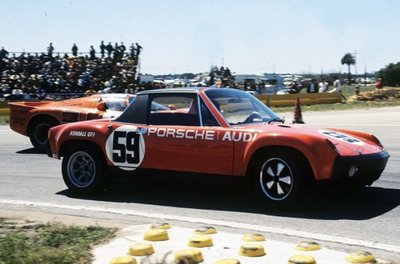Porsche's 914 to be honored at the 2015 Amelia Island Concours d'Elegance

A Brumos 914/6 at Sebring in 1971. Photos by Bill Warner.
For years, the Porsche 914 was the Rodney Dangerfield of the Zuffenhausen product line: among Porsche purists, it simply couldn’t get any respect, despite its success on the racetrack. Perhaps it was the car’s diminutive size, or its relatively modest power output in four-cylinder form, or its ties to Volkswagen, but the 914 was rarely spoken of in the same sentence as the venerable 911. That attitude has been steadily changing as the years tick by, and as further proof of the 914′s significance to automotive history, it will be honored at the 20th annual Amelia Island Concours d’Elegance.
Though today Porsche shuns the idea of an entry-level model, in the late 1960s the German sports car brand was in search of every customer it could attract. Initially, the automaker’s solution was the Porsche 912, a four-cylinder version of the Porsche 911 that offered acceptable performance and superlative handling at a price attainable by a broader audience. To replace the 912 in the product lineup, Porsche turned to development partner Volkswagen, and together they laid the groundwork for a compact, lightweight, mid-engine sports car.
The Duval Bailey Porsche 914/6 at the 1971 Daytona 24 Hours.
Initially, both Porsche and Volkswagen were to get a version of the final product, with Porsche’s variant powered by an air-cooled flat-six and VW’s model powered by an air-cooled flat-four. Porsche soon realized that such a move would, perhaps, take its brand a bit too far down market, and successfully lobbied Volkswagen to give it exclusive rights to both four and six-cylinder models.
When Volkswagen’s chairman, Heinz Nordhof, died shortly after the first 914 prototype was delivered to Porsche, things got complicated. Nordhof’s replacement, Kurt Lotz, refused to honor an informal agreement between the two automakers that precluded Porsche from paying tooling costs, and hence the cost of each 914 chassis delivered to Stuttgart rose significantly. While the four-cylinder 914 was still (marginally) cost effective, the six-cylinder 914/6 was priced nearly as high as the entry-level 911, thus limiting the car’s appeal. A later variant, the 916, would have offered both six-cylinder power and aggressive wide-body styling with flared fenders, but the car was deemed too expensive for production and the project was cancelled after just 11 prototypes were built.
The ex-Peter Gregg 916, one of just 11 examples built.
Despite the increased cost for all version, the base 914 proved to be a popular model for Porsche, with sales likely spurred on by the car’s racing successes. As Amelia Island Concours d’Elegance founder Bill Warner recalls, “…the Porsche 914 found a home and willing customers through the racing exploits of Peter Gregg, Hurley Haywood and Brumos Porsche, who took the 914/6 GT to victory in the first IMSA GT race in history on the way to winning the first IMSA GT Championship title in 1971.”
Legendary 911 racer Hurley Haywood remembers the 914/6 GT as, “…my first real race car. Peter Gregg and I shared the championship in 1971 in my first year of professional racing. The 914 was really fun to drive and we would kill the big-block Chevys and Fords in IMSA.”
The Porsche 914 captured victory in half the races on the 1971 IMSA GT schedule, but its sweetest victory may have come at Le Mans in 1970; not only did a 914/6 capture a GT class victory, but it finished the race three laps ahead of the best-finishing Porsche 911.
The 2015 Amelia Island Concours d’Elegance will take place on March 13-15, 2015. For additional details, visit AmeliaConcours.org.

